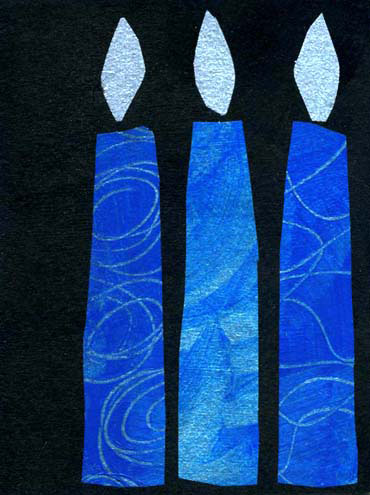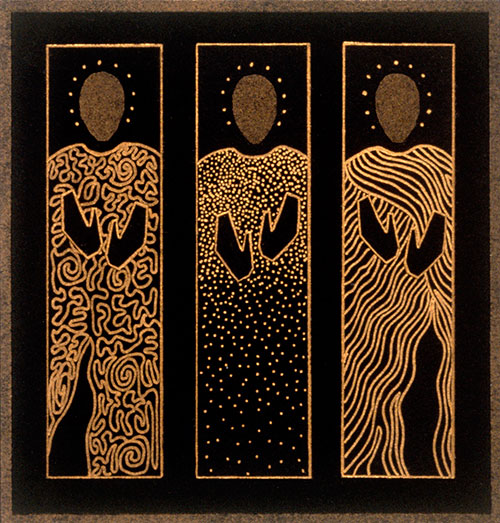
Get Real © Jan L. Richardson
Reading from the Gospels, Epiphany 4, Year C: Luke 4.21-30
In an interview with Terry Gross on her radio program Fresh Air some years ago, author Stephen King talked about how the adulation he encounters among readers sometimes turns so quickly to animosity. Acknowledging that he has become a lightning rod that draws a certain kind of fan psychology, he described how it occasionally happens that, for instance, “they want your autograph, they want to tell you how much they enjoy your stuff, and if you say look, I’d love to sign your books, but I can’t right now, I’m taking my family out to dinner, or I really have to be over here…their reaction is, go to hell, you son of a…. Just like that, it changes.”
Although it’s pretty easy to spot this adulation-animosity dynamic in its more dramatic forms (“We keep files on them,” King says of some of his readers who live at the farther, scarier reaches of this spectrum), I suspect we each carry this tendency within us. There’s something in our human psychology—more pronounced in some folks, to be sure, but present to a degree in us all—that tempts us to either idolize or demonize others. In particular, those who are in the public eye become, as Stephen King put it, lightning rods for this kind of phenomenon. Seeing bits and pieces of the life of another—a politician, a movie star, or even—as we observe in today’s gospel lesson—a preacher, we extrapolate from those pieces, put them together in a picture of who we think that person is, often magnifying certain traits (real or imagined) and ignoring others. In the process, we create a caricature that becomes easy to laud or to vilify.
Such responses are rooted in our illusions, in our projections, in our failure to see another for who they are. And because these perceptions are rooted in such shaky ground, it can become stunningly easy to flip from one pole of emotion to the other, usually in the direction of lambasting the one we once lauded.
We see this in today’s gospel lesson, which continues the story from last week of Jesus’ return to his hometown, where he reads from the scroll of Isaiah—those stunning words of good news to the poor, release to the captives, sight to the blind, and freedom to the oppressed—and proclaims to the gathering that these words have been fulfilled in their hearing. As Luke tells the story, Jesus’ teaching initially inspires awe, and then incredulity at what this hometown boy—“Is not this Joseph’s son?”—is speaking.
Jesus challenges their reaction with two stories. Again, as with last week, we see the power of how Jesus the Word carries the scriptures of his people within himself. The stories that Jesus tells to the gathering in the synagogue are stories of two people—one a widow, one a military commander—to whom God sends aid. God sees these people as they are. God knows their need. God meets their need in a way they don’t anticipate and, in the case of Naaman the commander, initially resists.
The subjects of Jesus’ two stories are also foreigners, strangers, people who live outside the covenant that God has with Israel. In telling these stories, and in observing that “no prophet is accepted in the prophet’s hometown,” Jesus challenges his hearers to remember that God crosses all boundaries and borders, including those that exist only in our own minds and hearts. Jesus challenges the way in which we often construct our beliefs about others and how God works in them: not only do we carry assumptions about those who are foreign to us, we also grow fixed in our understandings of those in our midst whom we think we know well. In both cases, our illusions and presumptions can prevent us from seeing the person who is really there, and can hinder us from receiving the sometimes surprising ways by which God is working in the life of this person, and wanting to work in our own life.
The incarnation and work of Jesus, to which we give particular attention in this season of Epiphany, was God’s way of saying to us, I see you. I see you, I know your need, I so want to be with you in your need that I will come among you in your own flesh, a body meeting your body, to see you, to be seen by you. To know you and to be known.
Some of the most powerful moments in the gospels come on those occasions, fairly rare, when someone recognizes who Jesus is: really sees him, knows him, understands what he’s about, perceives him in a balanced way absent of the extremes of adulation or denigration. Think of Peter, proclaiming, “You are the Christ.” Or the women who anoint Jesus in his final days, perceiving who he is and ministering to him in anticipation of the suffering he will soon endure. Or Mary Magdalene on Easter morning, exclaiming “Rabboni!” after Jesus has called her by name. One gets the sense from such stories that these people recognize Jesus because he has recognized them, has truly seen who they are: without illusion, without projection, without judgment, and with the utter and complete love that calls them to move more deeply into the heart of God and into the person God has created and called them to be.
The other lectionary texts this week speak with such brilliance to the power of what it means to seek and be seen by this God who knows us fully. “Before I formed you in the womb I knew you,” God says to Jeremiah, “and before you were born I consecrated you….” “Upon you I have leaned from my birth,” sings the psalmist; “it was you who took me from my mother’s womb.” “For now we see in a mirror, dimly,” Paul writes in his first letter to the Corinthians, “but then we will see face to face. Now I know only in part; then I will know fully, even as I have been fully known.”
The spiritual practices we find in the Christian tradition are treasures that help us seek this kind of seeing, this kind of knowing, even if partial: they help us to wipe at least a few of the smudges from the mirror. Amid what is strange and what is familiar—both of which can blind us to what is really present—practices of prayer, silence, spiritual direction, fasting, and the like help us strip away the layers of illusion and false perception. What we find through these practices can be uncomfortable and sometimes painful: who wants to have this kind of mirror, even a dim one, held up to ourselves?
And it is, in part, this experience of seeing themselves in Jesus’ mirror that infuriates the crowd in Luke’s story, flips them from amazement to agony, and prompts them to drive Jesus to the nearest cliff, intending to fling him over the side. We do well here to check our own assumptions and to heed the caution that Sarah Dylan Breuer offers in her excellent reflection on this passage: “And whatever we say about this Sunday’s gospel, please let’s not say that it is in any way about the small-mindedness of Jews in Jesus’ day or any other.” (She also suggests that “It can be dangerous to choose a pulpit too close to a cliff.”) The impulse to switch from adulation to assault isn’t reserved to any particular group; instead, it’s frighteningly pervasive.
Yet when we allow ourselves to truly see and be seen—when the Christ in me meets and knows and is known by the Christ in you—there is nothing in the world that compares with that. When we can move past our assumptions, our projections, our impulse to build perceptions on paltry fragments and partial sight; when we can open ourselves to the ways that God comes to us both in the stranger and in the one we think we know so well; when we can recognize and respond to the presence of God in another and, in that reflection, recognize the presence of God in our own selves: well, that’s enough to change the world.
So where is God hiding out for you these days? How do you keep your eyes open to the holy that goes in the guise not only of strangers but also of those who are so familiar to you? Upon what do you build your impressions of others? Are there practices that help you see others and yourself more clearly, that help you move beyond assumptions and illusions and imaginings and to see what and who is really there?
In this Epiphany season, in the strange and in the familiar, may we see and know the presence of the Christ who seeks us. Blessings.
[To use this image, please visit this page at janrichardsonimages.com. Your use of the Jan Richardson Images site helps make the ministry of The Painted Prayerbook possible. Thank you!]

























